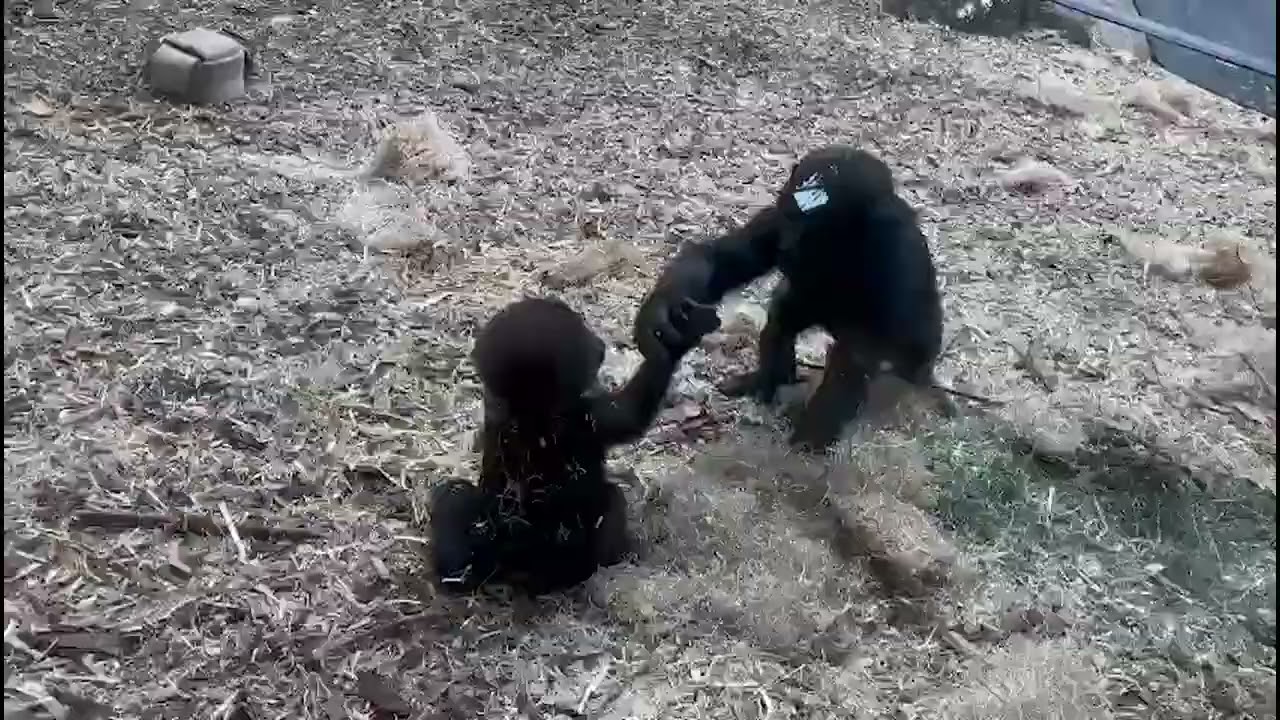– Exploring the behavior of Western Lowland Gorillas through the endearing interactions of half-siblings’ Eyare’ and ‘Okabe.’
– The emotional complexities observed in gorilla social dynamics, particularly in familial bonds.
– The significance of touch and physical connection in gorilla communities and what it indicates about their social structures.
– The role of zoos in conservation efforts, research, and public education, as seen through gorilla interactions.
A heartwarming scene plays out in a lush habitat; two Western Lowland Gorillas, each weighing hundreds of pounds, embody a moment of tenderness that contradicts their formidable presence. As ‘Eyare’ and ‘Okabe’ reach out and hold hands, their behaviors offer us a window into the rich emotional lives of these majestic primates. Though each gorilla’s story is one of survival and conservation, their simple gesture of connection speaks volumes about the bonds that tie their social worlds together.
Despite sharing just one parent, these half-siblings display the complexity of relationships within gorilla families. Their actions might be reminiscent of our human expressions of affection and support. Through a simple clasp of hands, ‘Eyare’ and ‘Okabe’ add depth to our understanding of the tight-knit communities these animals form.
Gorillas, though mighty, are known for their gentle nature and strong family bonds. The Western Lowland Gorilla, a species that calls the dense rainforests of Central Africa home, is particularly renowned for its intricate social structures. These animals live in troops, typically led by one dominant male, known as a silverback, due to the distinctive hair color on his back, with multiple females and their offspring making up the rest of the group.
But let’s turn our gaze back to this breathtaking moment – the half-sibling hug. Such gestures are not casual; they are a testament to gorillas’ intelligence and emotional capacity. These behaviors are affirmations of belonging, comfort, and reassurance amidst the group, arrows pointing to the heart of gorilla society: kinship and connection. Furthermore, these interactions can help researchers identify various relationships and hierarchies within these groups.
In the world of gorilla social behavior, touch is pivotal. It’s utilized for grooming, play, conflict resolution, and affection. Interestingly, grooming serves more than just a hygienic purpose; it’s crucial for maintaining social bonds and demonstrating trust. When ‘Eyare’ and ‘Okabe’ hold hands, they are participating in a deep-rooted tradition of connection that helps to reinforce their place within the social tapestry of their troop.
As fascinating as these behaviors are, they also reflect an essential aspect of gorilla life: their vulnerability. The Western Lowland Gorilla is classified as critically endangered. Threats such as habitat destruction, poaching, and disease have drastically impacted their populations in the wild. This stark reality serves as a reminder of the importance of conservation efforts and the role of accredited zoos in these endeavors.
Conservation is not just about protecting animals but about understanding them. Zoos, now metamorphosed from menageries to centers of conservation science, play a pivotal role in this understanding. They provide safe environments for endangered species and strive to replicate natural habitats that allow natural behaviors to flourish – including affectionate displays like our gorillas’ handholding.
Moreover, zoos act as living libraries, fostering education and research. They allow scientists to observe and document behaviors in real-time, offering insights that can inform conservation strategies and aid in revitalizing species in the wild. Data collected from these observations can be a critical asset in wildlife management decisions.
The bond between ‘Eyare’ and ‘Okabe’ also becomes a symbolic tool for conservation education. The empathy and interest they evoke in visitors underscore that these animals, with their nuanced social lives and emotional expressions, are more than just exhibits; they are ambassadors for their species and the wild places they represent.
When we gaze into the habitat and catch such sentient moments, we are not just onlookers but participants in a greater narrative of life on Earth. The responsibility to protect these creatures and their environments becomes personal and transformative. This transformation is what conservation-minded institutions aim for – a shift in perception that aligns human activity with the vitality of ecological stewardship.
Encounters with animals like ‘Eyare’ and ‘Okabe’ do more than entertain; they motivate. They inspire laypeople and scientists alike to ask questions, seek understanding, and pursue actions that contribute to a sustainable coexistence with our planet’s diverse wildlife.
Let this image of the ‘Eyare’ and ‘Okabe’ hand-hold be a symbolic handshake between humanity and nature, a pledge of solidarity with the world we are still learning so much about. May their affection inspire us all to hold tightly to the cause of conservation and champion the uncommon connections that form the bedrock of our shared existence on this blue and green marble we call home.
In closing, the next time you stumble upon a video or photograph capturing such an intimate moment within the gorilla’s world, remember there’s more to this than a fleeting feeling of awe. These are the threads that weave the rich tapestry of our biosphere, patterns of life that we are not apart from but a part of. They invite us to observe, reflect, and protect the delicate balance of biodiversity that sustains us all.
*****
Source Description
Don’t mind us; we’ll keep repeatedly watching this video of our western lowland gorilla half-siblings Eyare’ and ‘Okabe’ holding hands. 🥰
#YourZooYYC #gorillas #westernlowlandgorilla

